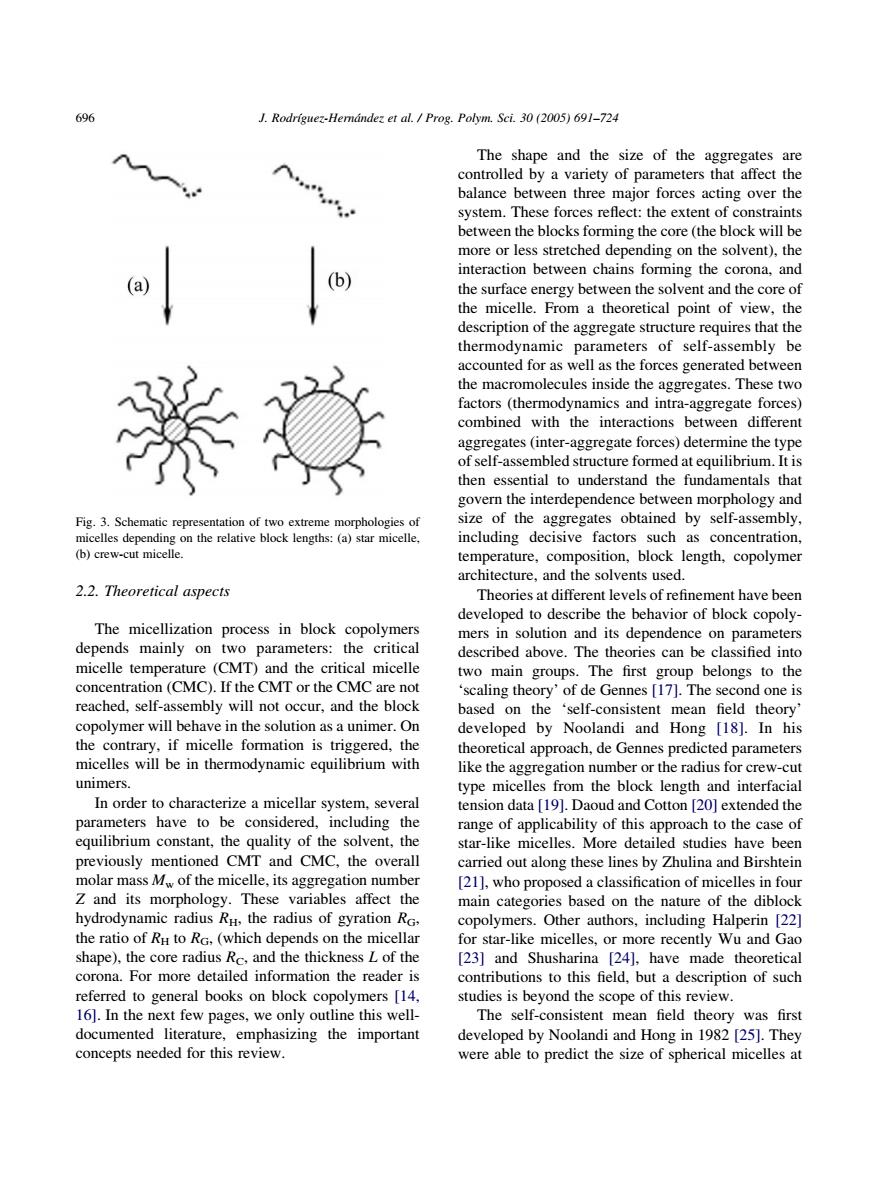正在加载图片...

696 J.Rodriguez-Herndndez et al.Prog.Polvm.Sci.30 (2005)691-724 n he sie of e aeet出 balance be by a varie ety of parameters system.These force refect:the of between the blocks forming the core (the block will be more or less stretched depending on the solvent).the (b) interaction between chains forming the corona.and the surface energy between the solvent and the core of the micelle.From a theoretical point of view.the ne aggregate structure requir 米尊 he mac cromolecules inside the ags gate forces combined with the interactions between different aggregates(inter-aggregate forces)determine the type of self-assembled structure formed at equilibrium.It is then essential to understand the fundamentals that dependence d sse the rela ati (b)crew-cut micelle. architecture.and the solvents used. 2.2.Theoretical aspects Theories at different levels of refinement have been developed to describe the behavior of block copoly. The micellization process in block mers in solution and its dependence on parameters lescribed above.The theories can be classified into (CMT and the ritical m concentration (CMC).If the CMT or the CMCa wo main groups.The belongs to the reached.self-assembly will not occur.and the block copolymer will behave in the solution as a unimer.On d by No the contrary,if micelle formation is triggered,the ch de cer micelles will be in thermodynamic equilibrium with like the ag ration number or the radius for crew unimers. ype micelles from the block length and interfacial In order to characterize a micellar system,several tension data [19).Daoud and Cotton [20]extended the have to co ding the ange of applicability of this approach to the case of th MT star-like micelles nd CM More detailed studies have out along th lines by Zhulina an 21 aa c Z and its morphology.These variables affect the hydrodynamic radius r..the radius of gvration R the ratio of ru to re (which depends on the micellar for star-like micelles or mor ntly Wu and Gac shape),the core radius Rc,and the thicknessLof the (231 and Shusharina 1241 have made theoretical corona.For more detailed information the reader is contributions to this field,but a description of such referred to general books on block copolymers [14. studies is beyond the scope of this review. 16].In the next few pages,we only outline this well The self-consistent mean field theory was first emphasizing the important They2.2. Theoretical aspects The micellization process in block copolymers depends mainly on two parameters: the critical micelle temperature (CMT) and the critical micelle concentration (CMC). If the CMT or the CMC are not reached, self-assembly will not occur, and the block copolymer will behave in the solution as a unimer. On the contrary, if micelle formation is triggered, the micelles will be in thermodynamic equilibrium with unimers. In order to characterize a micellar system, several parameters have to be considered, including the equilibrium constant, the quality of the solvent, the previously mentioned CMT and CMC, the overall molar mass Mw of the micelle, its aggregation number Z and its morphology. These variables affect the hydrodynamic radius RH, the radius of gyration RG, the ratio of RH to RG, (which depends on the micellar shape), the core radius RC, and the thickness L of the corona. For more detailed information the reader is referred to general books on block copolymers [14, 16]. In the next few pages, we only outline this welldocumented literature, emphasizing the important concepts needed for this review. The shape and the size of the aggregates are controlled by a variety of parameters that affect the balance between three major forces acting over the system. These forces reflect: the extent of constraints between the blocks forming the core (the block will be more or less stretched depending on the solvent), the interaction between chains forming the corona, and the surface energy between the solvent and the core of the micelle. From a theoretical point of view, the description of the aggregate structure requires that the thermodynamic parameters of self-assembly be accounted for as well as the forces generated between the macromolecules inside the aggregates. These two factors (thermodynamics and intra-aggregate forces) combined with the interactions between different aggregates (inter-aggregate forces) determine the type of self-assembled structure formed at equilibrium. It is then essential to understand the fundamentals that govern the interdependence between morphology and size of the aggregates obtained by self-assembly, including decisive factors such as concentration, temperature, composition, block length, copolymer architecture, and the solvents used. Theories at different levels of refinement have been developed to describe the behavior of block copolymers in solution and its dependence on parameters described above. The theories can be classified into two main groups. The first group belongs to the ‘scaling theory’ of de Gennes [17]. The second one is based on the ‘self-consistent mean field theory’ developed by Noolandi and Hong [18]. In his theoretical approach, de Gennes predicted parameters like the aggregation number or the radius for crew-cut type micelles from the block length and interfacial tension data [19]. Daoud and Cotton [20] extended the range of applicability of this approach to the case of star-like micelles. More detailed studies have been carried out along these lines by Zhulina and Birshtein [21], who proposed a classification of micelles in four main categories based on the nature of the diblock copolymers. Other authors, including Halperin [22] for star-like micelles, or more recently Wu and Gao [23] and Shusharina [24], have made theoretical contributions to this field, but a description of such studies is beyond the scope of this review. The self-consistent mean field theory was first developed by Noolandi and Hong in 1982 [25]. They were able to predict the size of spherical micelles at Fig. 3. Schematic representation of two extreme morphologies of micelles depending on the relative block lengths: (a) star micelle, (b) crew-cut micelle. 696 J. Rodrı´guez-Herna´ndez et al. / Prog. Polym. Sci. 30 (2005) 691–724